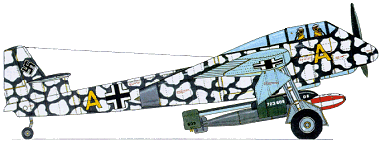Blohm & Voss BV P.194
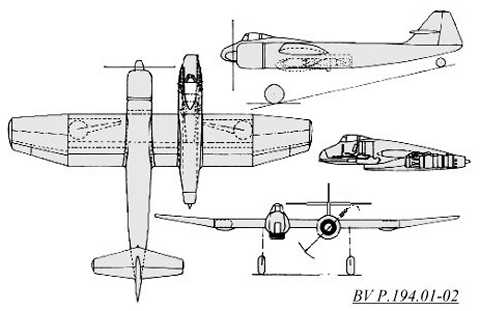
In March 1944, Blohm & Voss put
forward a proposal to the RLM for a new asymmetrical aircraft, which could
be used in a number of roles: fighter, destroyer, dive bomber and reconnaissance.
Blohm & Voss had previous experience with their BV 141 in building and
flying asymmetric aircraft, and at the time they were working on the
BV 237
and the BV P.179
, two other asymmetrical designs from Dip. Ing. Richard Vogt. This project
was different because it featured a mixed propulsion scheme, that is, both
propeller and jet driven, plus an internal bomb stowage in the main fuselage.
As the original Blohm & Voss proposal stated:
"This arrangement gives the asymmetric aeroplane a number of advantages,
the greatest being an unobstructed view for the pilot as well as the possibility
of great weapon concentration. Also, it greatly reduces the torque moment
produced around the vertical axis by the propeller in the single engined
configuration. At take-off in particular this motion is expected to be less
than half that of the BV141. After take-off the moment is reduced to less
than a third and it completely disappears at high speed cruise settings."
The BV proposal went on to say that the distance between the pilot and the
center of gravity was 180 cm (5' 11") in the Bv 141, 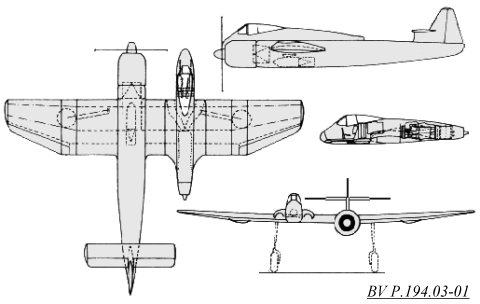 but that in the BV P.194 the distance had been reduced to 145 cm (4' 9")
. Due to this, Blohm & Voss proposed that instead of calling the
BV P.194 an asymmetric design, it should be more correctly called "a not
fully symmetrical aeroplane"!
but that in the BV P.194 the distance had been reduced to 145 cm (4' 9")
. Due to this, Blohm & Voss proposed that instead of calling the
BV P.194 an asymmetric design, it should be more correctly called "a not
fully symmetrical aeroplane"!
The table below
shows the advantages and disadvantages of various types of aircraft, as
shown in the BV proposal.
Although there were several different
designs for the BV P.194 (see table below
), the basic airframe was the same. The proportion of steel to dural was
62% to 38%, and the steel was not thin sheet metal, but a thicker steel sheeting
that could easily be electrically welded. The main fuselage was of a rolled
shell construction, with a internal bomb bay or camera installation. The bomb
bay could hold a variety of bomb loads, as shown in the table
below
. A single BMW 801 D radial engine of 1700 horsepower was mounted in the
front of the main fuselage and drove a three bladed 3.5 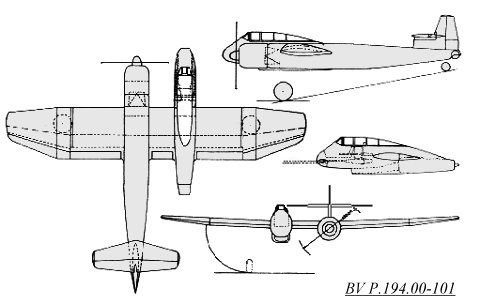 meter (11' 6") propeller. The wing spars are made of welded steel box sections,
and also serve as armored fuel tanks, capacity of 2100 liters (555 gallons).
Dural construction was to be used for the inner and outer wing panels, and
the inner wing section is detachable from both the cockpit gondola and main
fuselage. There are also three sets of landing flaps which are hydraulically
controlled. The single fin is welded into the fuselage, and the rudder is
constructed of Dural and is also hydraulically actuated. The cockpit is situated
in a gondola located on the starboard wing, and is constructed of armored
steel in the front and Dural in the rear. A single jet engine, either a BMW
003 or Jumo 004, is mounted below the cockpit and is angled slightly upwards.
A conventional "tail dragger" landing gear arrangement was chosen, with the
main gear retracting outboard into the wings and the tail wheel retracting
into the fuselage; all were hydraulically retracted. Offensive armament consisted
of two MK103 30 mm cannon with 140 rounds each and two MG151 20mm cannon
with 500 rounds each, all mounted in the cockpit gondola sides and firing
forwards. Due to the late date this project was proposed, and the worsening
war situation for Germany, the P.194 development was not pursued.
meter (11' 6") propeller. The wing spars are made of welded steel box sections,
and also serve as armored fuel tanks, capacity of 2100 liters (555 gallons).
Dural construction was to be used for the inner and outer wing panels, and
the inner wing section is detachable from both the cockpit gondola and main
fuselage. There are also three sets of landing flaps which are hydraulically
controlled. The single fin is welded into the fuselage, and the rudder is
constructed of Dural and is also hydraulically actuated. The cockpit is situated
in a gondola located on the starboard wing, and is constructed of armored
steel in the front and Dural in the rear. A single jet engine, either a BMW
003 or Jumo 004, is mounted below the cockpit and is angled slightly upwards.
A conventional "tail dragger" landing gear arrangement was chosen, with the
main gear retracting outboard into the wings and the tail wheel retracting
into the fuselage; all were hydraulically retracted. Offensive armament consisted
of two MK103 30 mm cannon with 140 rounds each and two MG151 20mm cannon
with 500 rounds each, all mounted in the cockpit gondola sides and firing
forwards. Due to the late date this project was proposed, and the worsening
war situation for Germany, the P.194 development was not pursued.
 View Gino Marcomini's BV P.194 Luft Art images
View Gino Marcomini's BV P.194 Luft Art images
Blohm & Voss BV P.194 Dimensions
*
| Span |
Length |
Height |
Cockpit Gondola
width - length - height** |
Bomb Bay
width - length - height |
Wing Area |
15.3 m
50' 2" |
11.8 m
38' 9" |
3.64 m
11' 11" |
1.2 m - 6.4 m - 2.05 m
3' 11" - 21' 0" - 6' 9" |
1.0 m - 4.0 m - 0.65 m
3' 3" - 13' 2" - 2' 2" |
36.4 m²
391.8 ft² |
Blohm & Voss BV P.194 Weights
| Empty Weight Equipped |
Flying Weight |
Max. Wing Loading |
Fuel Weight
(BMW 801D - BMW 003) |
6500 kg
14330 lbs |
9150 kg
20172 lbs |
252 kg/m²
51.48 lbs/ft² |
730 kg - 1000 kg
1609 lbs - 2205 lbs |
Blohm & Voss BV P.194 Performance
| Max. Speed † |
Rate of Climb † |
Takeoff
Distance |
Takeoff
Speed |
Landing
Speed |
Ceiling |
Range |
| @ |
0 km
0 ft |
640 km/h
398 mph |
| @ |
2 km
6562' |
675 km/h
419 mph |
| @ |
4 km
13123' |
680 km/h
423 mph |
| @ |
6 km
19685' |
710 km/h
441 mph |
| @ |
8 km
26247' |
715 km/h
444 mph |
|
| @ |
0 km
0 ft |
19.2 m/s
63.0 ft/s |
| @ |
2 km
6562' |
17.6 m/s
57.7 ft/s |
| @ |
4 km
13123' |
15.1 m/s
49.5 ft/s |
| @ |
6 km
19685' |
13.9 m/s
45.6 ft/s |
| @ |
8 km
26247' |
9.1 m/s
29.9 ft/s |
|
600 m
1968' |
180 km/h
112 mph |
150 km/h
93 mph |
11200 m
36745' |
| @ |
0 km
0 ft |
930 km
578 miles |
| @ |
2 km
6562' |
960 km
597 miles |
| @ |
4 km
13123' |
1060 km
659 miles |
| @ |
6 km
19685' |
1070 km
665 miles |
|
* Data in tables for P.194.02-01 variant
** Height including jet engine
† w/ methanol injection
Blohm & Voss BV
P.194 Models
| Manufacturer |
Scale |
Material |
Notes |
| Czechmaster #246 |
1/72 |
resin |
slightly flattened jet air intake,
no cockpit gondola weapon bulges |
| Revell #04335 |
1/72 |
injected & decals |
detailed bomb bay and nice decals |
| Special Hobby #72008 |
1/72 |
injected, photoetch & decals |
BV P.194.02-01
version, correctly models the
cockpit gondola weapon bulges and jet intake shape |
Blohm & Voss proposal three-view
drawing of the BV P.194
BV P.194 Variants
|
Variant
|
Features
|
Span
|
Length
|
| BV P.194.01-02 |
- One of the MK103 30 mm cannon could
be replaced by a MK412 55mm cannon
- Engine mounted slightly below cockpit
and fed by flattened air intake |
15.3 m
50' 2" |
12.1 m
39' 8" |
| BV P.194.02-01
|
- Example described in main entry |
15.3 m
50' 2" |
11.8 m
38' 9" |
| BV P.194.03-01 |
- Engine mounted directly behind cockpit
and fed by air intakes on fuselage sides
- Stepped tail unit
- Redesigned cockpit nose |
14.3 m
46' 11" |
11.94 m
39' 2" |
| BV P.194.00-101 |
- Two man version, pilot and observer/radio
operator sat back-to-back
- Engine as in P.194.01-02
- Stepped tail unit |
16 m
52' 6" |
12.75 m
41' 10" |
Bomb Bay details of the BV P.194
9 SC70 Total: 630 kg
2 SC250 Total: 500 kg
1 SC500 Total: 500 kg
1 SC1000 Total: 1000 kg*
* (in overload condition,
bomb protrudes slightly
out of bomb bay) |
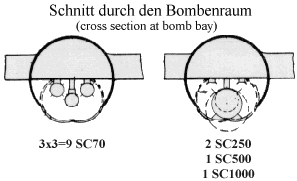
|
Advantages & disadvantages of various aircraft types
(as per Blohm & Voss proposal of March 1944 for BV
P.194)
Fighter
x Insufficient visibility
x Insufficient weapons concentration
x Very difficult to carry meaningful bomb loads
x Insufficient low level speed
x Insufficient climb speed
 Cheap to build and maintain
Cheap to build and maintain
|

|
Heavy Fighter (Destroyer)
 Good visibility
Good visibility
 Good weapons concentration
Good weapons concentration
 Good bomb load
Good bomb load
x Not quite enough speed at low level
 Good climb speed
Good climb speed
x Expensive to build and maintain
|

|
Heavy Fighter (Dornier 335)
x Insufficient visibility
x Insufficient weapons concentration
x Very difficult to load with bombs
 Good low level speed
Good low level speed
 Good climbing speed
Good climbing speed
x Expensive to build and maintain
x No air-cooled motors
x Crankshaft extensions
|

|
Enlarged Me 262
 Good visibility
Good visibility
 Good weapons concentration
Good weapons concentration
 Good bomb load and easily accessible bomb mounts
Good bomb load and easily accessible bomb mounts
x Vulnerable at take-off
 Good low level speed
Good low level speed
x Insufficient climbing speed
x Short operational range
 Cheap to build and maintain
Cheap to build and maintain
|

|
BV P.194
 Good visibility
Good visibility
 Good weapons concentration
Good weapons concentration
 Good bomb load and easily accessible bomb bay
Good bomb load and easily accessible bomb bay
 Good low level speed
Good low level speed
 Good climbing speed
Good climbing speed
 Cheap to build and maintain
Cheap to build and maintain
|

|
Color illustrations above from Reichdreams
Dossiers #13: Asymmetric Planes

 but that in the BV P.194 the distance had been reduced to 145 cm (4' 9")
. Due to this, Blohm & Voss proposed that instead of calling the
BV P.194 an asymmetric design, it should be more correctly called "a not
fully symmetrical aeroplane"!
but that in the BV P.194 the distance had been reduced to 145 cm (4' 9")
. Due to this, Blohm & Voss proposed that instead of calling the
BV P.194 an asymmetric design, it should be more correctly called "a not
fully symmetrical aeroplane"!  meter (11' 6") propeller. The wing spars are made of welded steel box sections,
and also serve as armored fuel tanks, capacity of 2100 liters (555 gallons).
Dural construction was to be used for the inner and outer wing panels, and
the inner wing section is detachable from both the cockpit gondola and main
fuselage. There are also three sets of landing flaps which are hydraulically
controlled. The single fin is welded into the fuselage, and the rudder is
constructed of Dural and is also hydraulically actuated. The cockpit is situated
in a gondola located on the starboard wing, and is constructed of armored
steel in the front and Dural in the rear. A single jet engine, either a BMW
003 or Jumo 004, is mounted below the cockpit and is angled slightly upwards.
A conventional "tail dragger" landing gear arrangement was chosen, with the
main gear retracting outboard into the wings and the tail wheel retracting
into the fuselage; all were hydraulically retracted. Offensive armament consisted
of two MK103 30 mm cannon with 140 rounds each and two MG151 20mm cannon
with 500 rounds each, all mounted in the cockpit gondola sides and firing
forwards. Due to the late date this project was proposed, and the worsening
war situation for Germany, the P.194 development was not pursued.
meter (11' 6") propeller. The wing spars are made of welded steel box sections,
and also serve as armored fuel tanks, capacity of 2100 liters (555 gallons).
Dural construction was to be used for the inner and outer wing panels, and
the inner wing section is detachable from both the cockpit gondola and main
fuselage. There are also three sets of landing flaps which are hydraulically
controlled. The single fin is welded into the fuselage, and the rudder is
constructed of Dural and is also hydraulically actuated. The cockpit is situated
in a gondola located on the starboard wing, and is constructed of armored
steel in the front and Dural in the rear. A single jet engine, either a BMW
003 or Jumo 004, is mounted below the cockpit and is angled slightly upwards.
A conventional "tail dragger" landing gear arrangement was chosen, with the
main gear retracting outboard into the wings and the tail wheel retracting
into the fuselage; all were hydraulically retracted. Offensive armament consisted
of two MK103 30 mm cannon with 140 rounds each and two MG151 20mm cannon
with 500 rounds each, all mounted in the cockpit gondola sides and firing
forwards. Due to the late date this project was proposed, and the worsening
war situation for Germany, the P.194 development was not pursued. 







